Cypherock Review 2024: The Safest Crypto Wallet?

Cypherock X1 is a hardware wallet employing encrypted NFC-based cards to store users' private keys and seed phrases. It offers an industry-leading secure option for those looking to protect their assets and mitigate the risks associated with seedphrases. With portfolio management and the ability to act as a seedphrase vault for up to 4 wallets, the Cypherock is one of the most secure wallets we've reviewed!
Welcome to the Coin Bureau and well done for taking the most important step in any crypto holder’s journey by travelling down the path of crypto self custody. Whether you have stumbled upon this review looking for your first or a secondary hardware wallet, taking ownership of your digital assets is a cornerstone of responsible and secure crypto wealth management.
This article is going to provide a comprehensive, detailed and in-depth look at the Cypherock hardware wallet. Our Cypherock review will illustrate the pros, cons, strengths and weaknesses of this device and ultimately highlight what makes Cypherock unique and not just another run-of-the-mill hardware wallet.
Cypherock Key Features:
- No Seed Phrase Vulnerability- Eliminates the common security risk associated with seed phrases.
- Audited by Keylabs- Ensures robustness, having been tested by the firm known for identifying vulnerabilities in other major hardware wallets like Trezor and Ledger.
- Decentralized Private Keys- Utilizes a Shamir Secret Sharing cryptographic technique to split the private key into five parts. This Enhances security by decentralizing the storage of private keys.
- Geographical Distribution of Keys- Allows for storing each part of the split key in different locations.
- Simplified Transaction Process- Requires just one of the four cards to be tapped on the wallet for transactions, simplifying the process while maintaining security.
- Elimination of Single Points of Failure- By not relying on a single seed phrase or storage point, it reduces the risk of total loss
- Manage Multiple Wallets- Users can import up to 4 private keys, allowing this device to be shared between users or for multi-wallet private key management.
- Bank-Grade Security- Each card is EAL6+ certified and the ATECC608A and STM32L4 components do not have any known hardware vulnerabilities
- DeFi and DApp Access- Through Wallet Connect, Cypherock users can participate in the world of decentralized finance.
- 3-Factor Authentication- The Cypherock X1 device, X1 card, and pin act as an effective 3FA for ultimate protection.
- Inheritance Feature- Coming soon will be a legacy inheritance feature to enable the passing of our crypto onto loved ones.
The folks over at Cypherock were kind enough to send us a couple of devices for testing and review purposes, so strap in as we dive deeper into the hardware wallet and explore how this slick piece of tech is rewriting the rules of digital asset security, one encrypted bit at a time!
Note: Though the Cypherock team sent us these devices for testing, we did not receive payment and all of our findings and opinions are our own. The Cypherock team did not influence the findings of this review, though I would like to thank them for their time in clarifying some topics and answering questions.
What Is Cypherock?
Cypherock is a relative newcomer to the hardware wallet scene, launching their product in open beta in 2022 with the full launch happening in 2023. Their flagship product, the Cypherock X1, has been acclaimed by some as the world’s safest hardware wallet, free from the vulnerabilities associated with seedphrases. This innovation is not just a claim; it's backed by rigorous security audits from WalletScrutiny and Keylabs, the same firm that identified weaknesses in well-known wallets like Ledger and Trezor. The Keylabs team had this to say about their findings:
“The Cypherock X1 is an innovative wallet that uses many hardware and software security best practices and even features several security firsts that we have not yet seen in other wallets” - Source
What sets the Cypherock X1 apart is its unique approach to securing private keys. Instead of relying on a single seed phrase, it decentralizes your private keys, amplifying security tenfold.
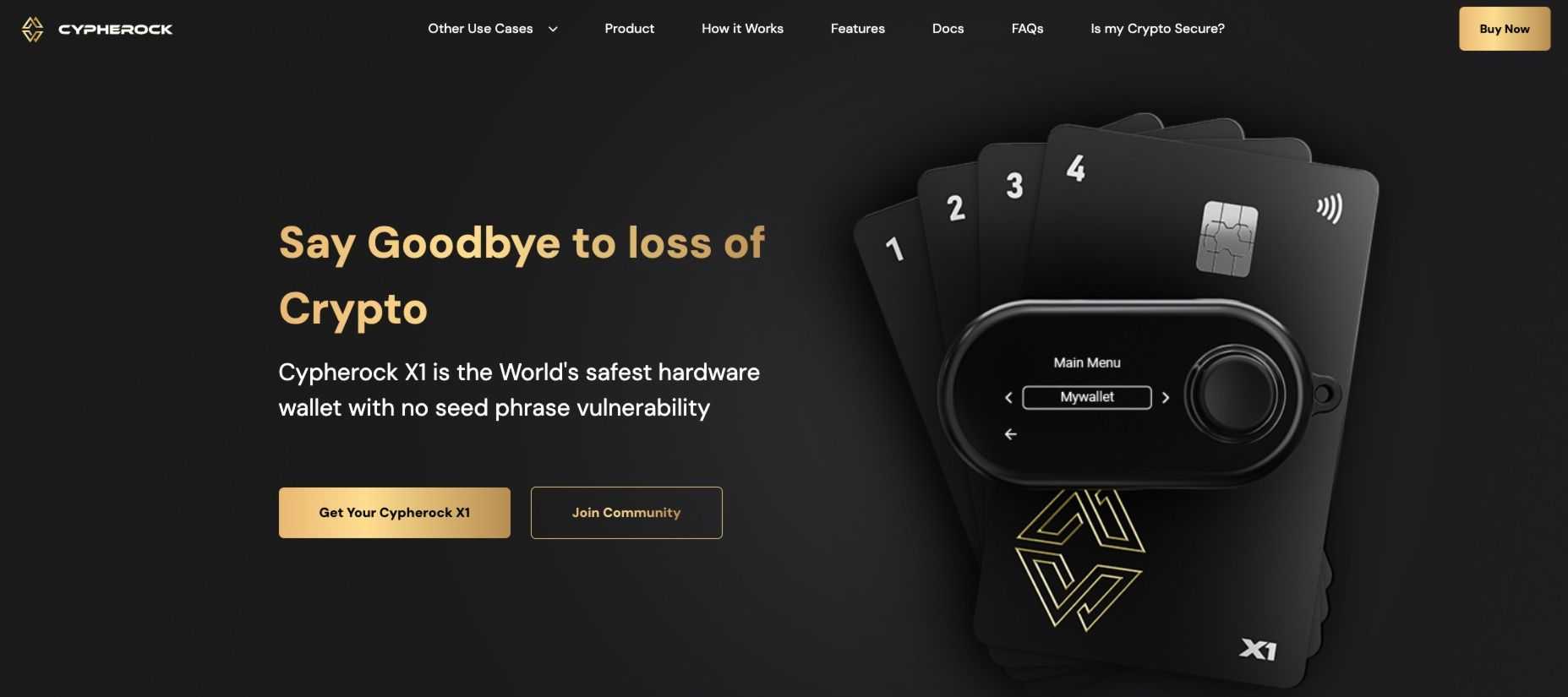
This decentralization is ingeniously implemented through Shamir's Secret Sharing, cryptographically splitting your private key into five segments. Each segment is securely stored on the X1 Vault and four X1 Cards, which are under your sole control and can be geographically distributed for added security.
Making a crypto transaction with the X1 is a breeze and despite the complex approach to security, the device is refreshingly user-friendly. Simply fetch and tap any one of the four cards on the X1 vault. This system eliminates the need for seed phrase backups and single points of failure, ensuring your peace of mind. It is also good to point out that users who choose Cypherock won’t be reliant on the device either, should your device break or become lost or Cypherock go out of business, there are ways to extract the recovery phrase and there is also an open-source mobile app that can be used with the cards for recovery of funds should the device become lost or broken.
Alright, that provides a high-level overview and the basics, we will go into much greater detail later on, but first, who is the team behind Cypherock?
Cypherock Team
The Cypherock team was inspired by the belief that the current methods of self-custody were not sufficient for mass adoption and felt they could create a better product, building and evolving upon the foundation built by industry pioneers such as Trezor and Ledger.
It is difficult to disagree with them as the #1 risk to user funds who self custody, is, believe it or not, user error. That’s right, when it comes to taking custody of our funds, our own fallibility has caused an estimated $100 billion worth of losses. Much of this was the result of users mismanaging their own recovery phrases/private keys.
We’ve also all likely heard the common complaints that crypto storage is too complicated and not user-friendly enough for mass markets. Cypherock believes they can not only reduce the risks involved with self-custody but create a user-friendly wallet that is fit for purpose and are even working on inheritance solutions as nobody should ever experience complete loss of funds.
Based out of India, Cypherock was created by Rohan Agarwal and Vipul Saini, who act as CEO and CTO respectively.
Rohan has been involved in software development since 2014 and entered the Crypto space in 2017. Over the years, he has collaborated with various organizations, including Blockgeeks, Fossasia (Google Summer of Code), Apollo Munich, Siftr Labs, Samsung and others. Demonstrating versatility, Rohan studied at the Delhi College of Engineering and has experience in both technical and non-technical roles throughout his career.
Vipul has immersed himself in the Crypto space since 2017 and holds expertise in Hardware Security and Embedded Engineering since 2012. He collaborated with Lockheed Martin on an autonomous drone project and played a pivotal role as the first employee at Nymble Labs, a venture-backed food robotics startup headquartered in SF, USA. Known for his penchant for frontier technologies, Vipul studied at Delhi Technological University and brings extensive experience to the Cypherock team.
Along with the core team, Cypherock is backed by some heavy hitters in the industry including the likes of GnosisDAO, the Co-Founder of Polygon Sandeep Nailwal, among others.

Why Cypherock is a Pioneering Trailblazer
First off, Cypherock waves goodbye to the Achilles' heel of crypto wallets - seed phrase vulnerability, while still allowing users to retain trustless control over their assets without needing to trust a third party. Seed phrase vulnerability refers to the multitude of ways in which trusting your recovery phrase to a fragile piece of paper can lead to complete loss of funds. We cover these risks in detail in our Zengo Review if you want to dive into the risks associated with seed phrases.
Eliminating seed phrases is only one arrow in their quiver, things get even better. Cypherock decentralizes your private keys, increasing recoverability and security.
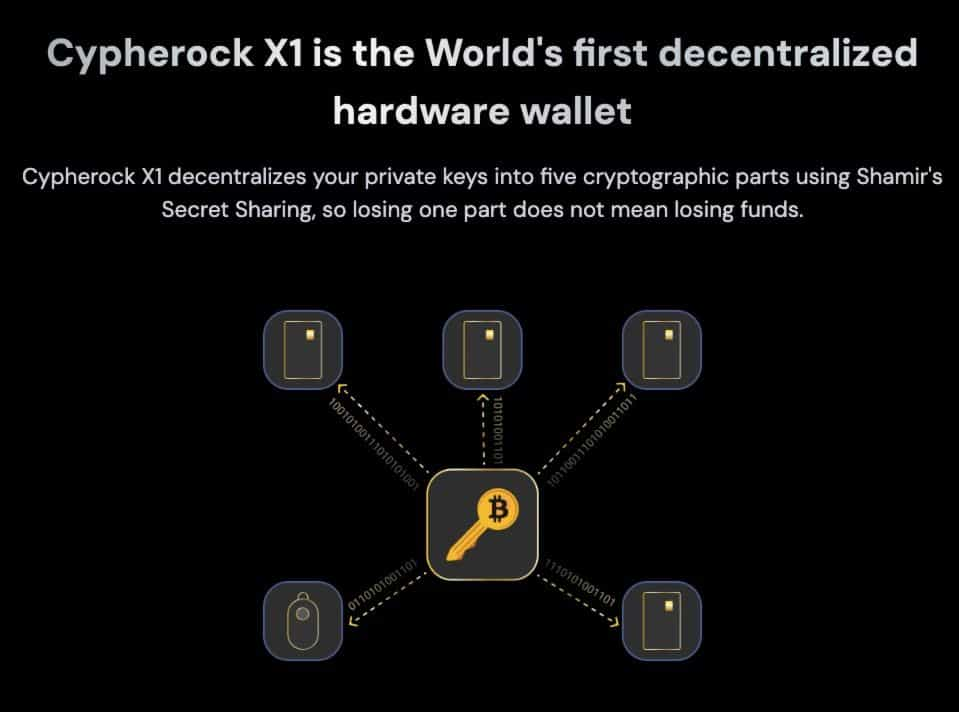
Think of it as diversifying your digital eggs into multiple, ultra-secure baskets. This isn't just a feature; it's a revolution in secure crypto wealth management. Using Shamir's Secret Sharing to split your key into five parts allows users to store the puzzle pieces in different locations. All a user needs to recover their funds is to have any two of the five devices, either two cards or a card and X1 Vault and they can recover their assets.
The third game changer is that the Cypherock team learned from the security vulnerabilities found in mainstream crypto wallets and created a device that is hackproof, protected against both physical and remote attacks.
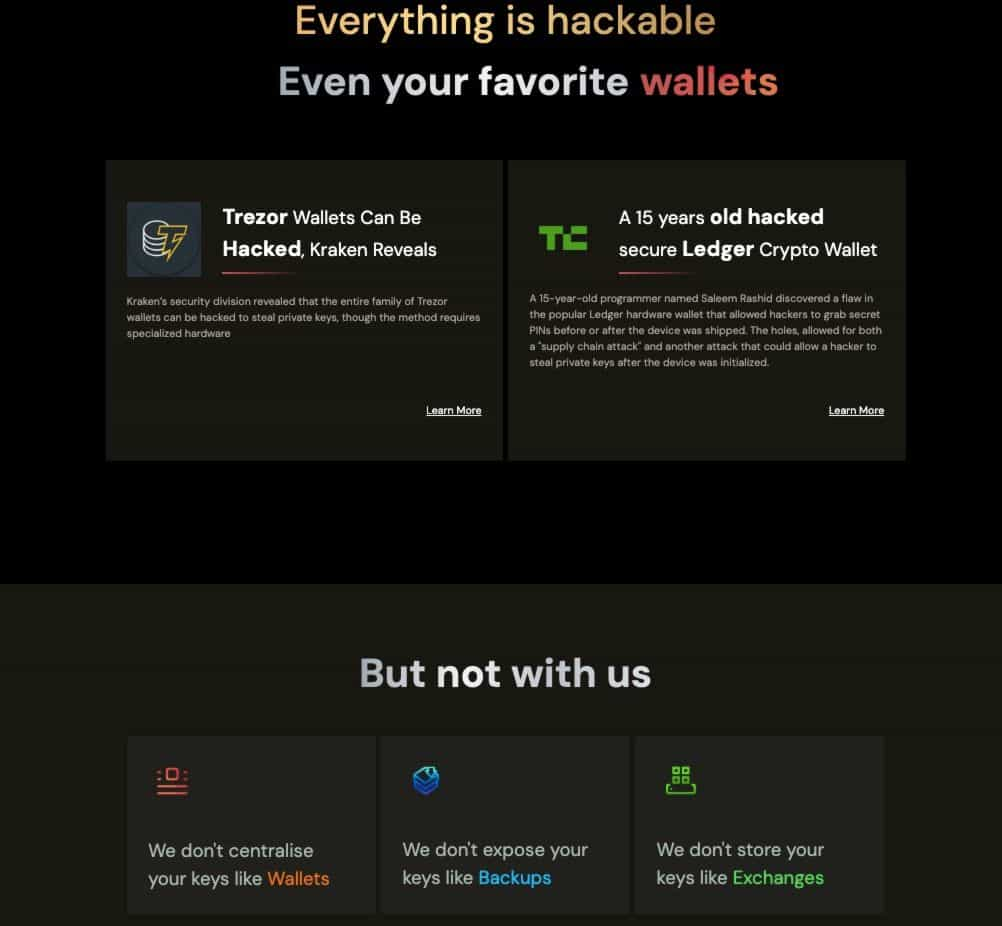
Security teams have found ways to hack into physical Trezor and Ledger devices using sophisticated techniques like voltage glitching to retrieve the private keys. Because the Cypherock X1 does not contain a full set of private keys (remember, they are split into 5 parts), not even the most sophisticated hackers will be able to break into your device to retrieve the keys.
The only concern would be if someone acquired two of the five pieces needed AND knew your pin code. As long as only you know the pin, you can sit back and trust the fortress that is Cypherock.
Cypherock's innovative approach simplifies transactions too. Just a tap of a card on the X1 vault, and voilà! It's crypto convenience at its best without the complexities of traditional hardware wallets or exposing your private keys to devices with internet connectivity. Oh, and Cypherock is compatible with MetaMask and other software wallets, so even DeFi users can enjoy the convenience of a software wallet with the security of a hardware wallet.
👉 Enjoy a 17% Discount Using our Cypherock Signup Link!
Cypherock Features
Okay, we’ve covered some of the key features from a wide-angle lens, now let’s get into some of the intricate moving parts.
No More Paper Backups
Crypto wallets utilize a key system—private and public keys—for transactions and signatures. Public keys create addresses for receiving, while private keys act as passwords for sending cryptocurrencies. BIP39 simplifies complex private keys with seed phrases, typically 12/18/24 words. Although easier for humans, securing seed phrases poses challenges.
Most backups are paper or metal, vulnerable to damage, loss, or theft, and don't solve the single point of failure issue. Cypherock X1, the world’s first seedless hardware wallet, employs Shamir Secret Sharing to split the private key into 5 shards stored on the X1 device and 4 X1 cards.
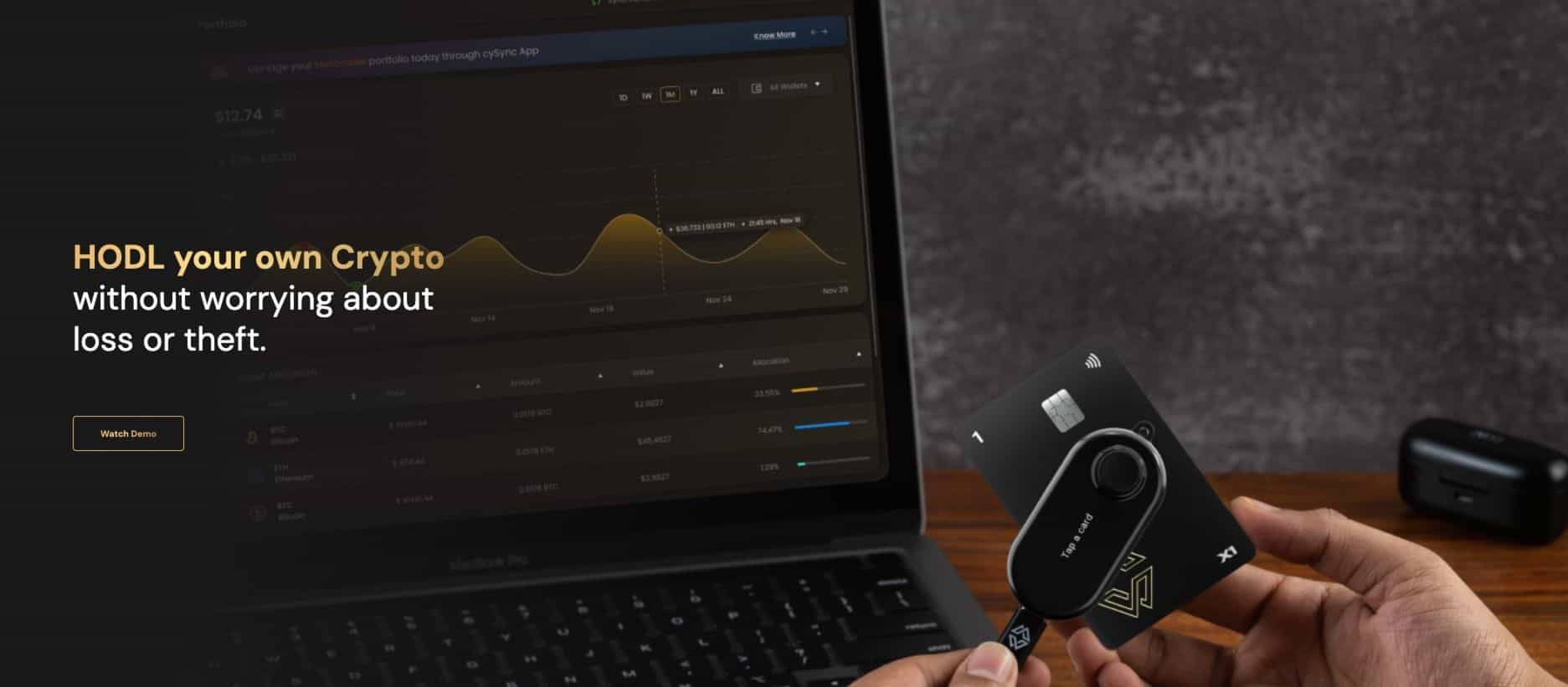
A 2/5 threshold is used for re-deriving the private key, enhancing security and eliminating the need for traditional seed phrases. The shards can be geographically distributed, meaning you can give one to your mom or your friend, keep one in a bank vault or keep it buried in your backyard. Cypherock X1's innovative approach removes the need for paper or metal backups.
The Shamir backup method isn’t just unique to Cypherock either. As it’s been shown to offer a safer way to secure private keys, some wallets and recovery phrase storage providers now offer solutions to accommodate Shamir Secret Sharing options, but Cypherock is the first one to build it directly into the wallet.
Open Source and Secure Elements
Open-source technology has fostered innovation and community engagement, particularly vital in web3 wallets where transparency is crucial. Many wallet manufacturers such as Trezor and Cypherock have chosen to open-source their products, gaining the trust of the community as anyone can go in and verify the code for themselves. Open-source code is often scrutinized far more than its closed-source counterparts due to the simple fact that more eyes are scouring through the code and if any vulnerabilities or malicious code is implanted, you bet the alarm bells will be raised by the community.
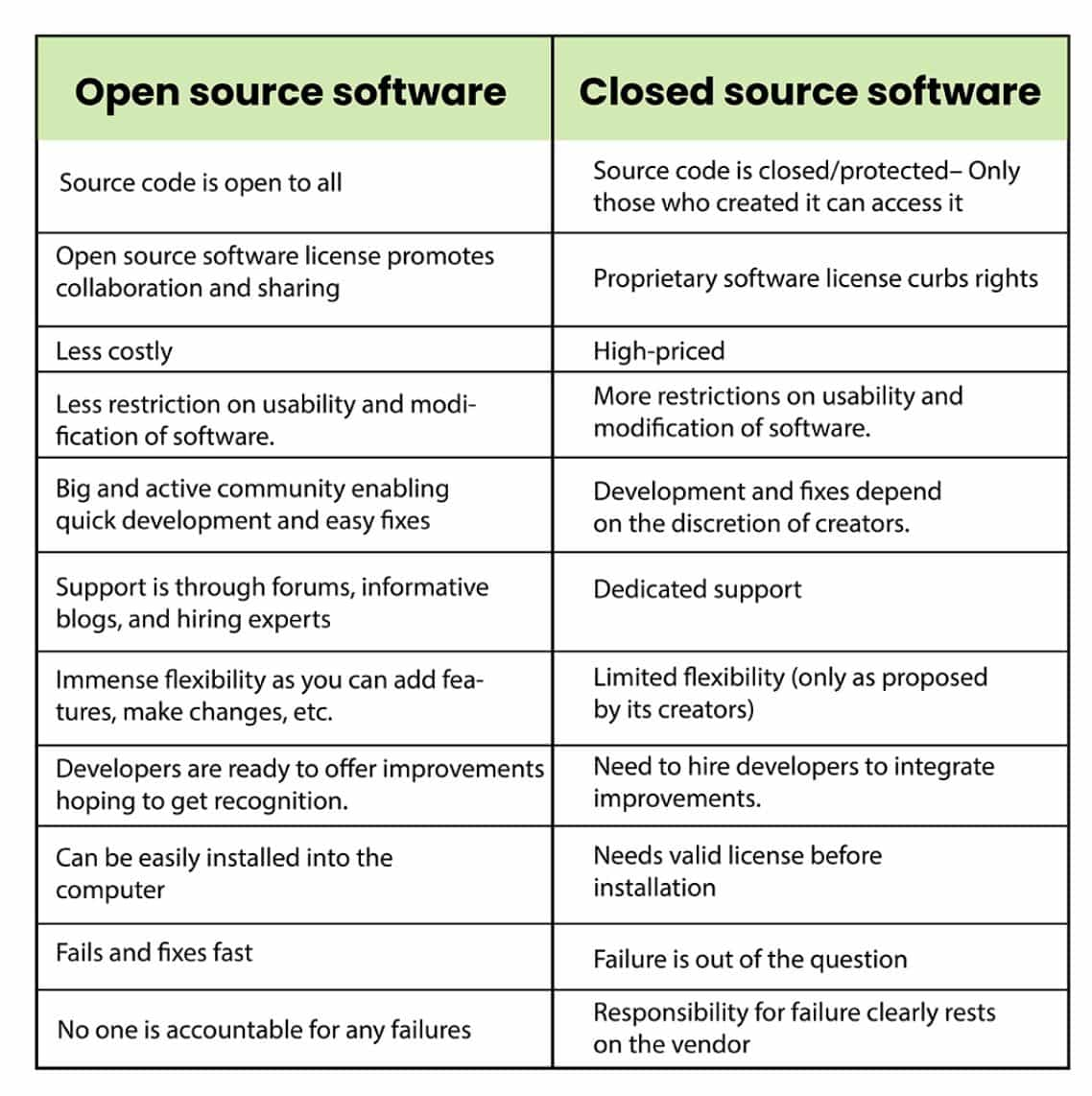
The crypto community was shocked in 2023 to learn what sorts of shenanigans can happen when wallets keep their source code closed and secret. I am, of course, talking about Ledger’s blunder with their recovery system that outraged many loyal Ledger users and sent them looking for alternatives. Many crypto security professionals will advocate for the importance of an open-source approach.
However, that is not to say that there are no security concerns with open-source projects, especially in cryptocurrency wallets dealing with sensitive data.
Security Risks:
- Decentralized development lacks a central authority to ensure the safety of software forks.
- Crypto wallets that are open-sourced may have vulnerabilities that are identified by malicious hackers and exploited before patches are available.
To address these risks, some wallets opt for closed-source approaches using secure elements. Cypherock X1 device is open for review, enhancing transparency, while the X1 cards' code remains proprietary. This approach allows for scrutiny of wallet operations while maintaining the security of private keys distributed across the X1 cards and Vault. Cypherock's design mitigates the associated risks, providing both openness and security.
The Ultimate Seed Phrase Vault
The Cypherock X1 can safeguard up to four wallets, each with its unique seed phrase and the option to apply distinct PINs. For instance, a user managing both a software and a hardware wallet with two distinct seed phrases can import these into the Cypherock X1, essentially transforming it into a secure seed phrase vault for optimal seed phrase management for multiple wallets or users.
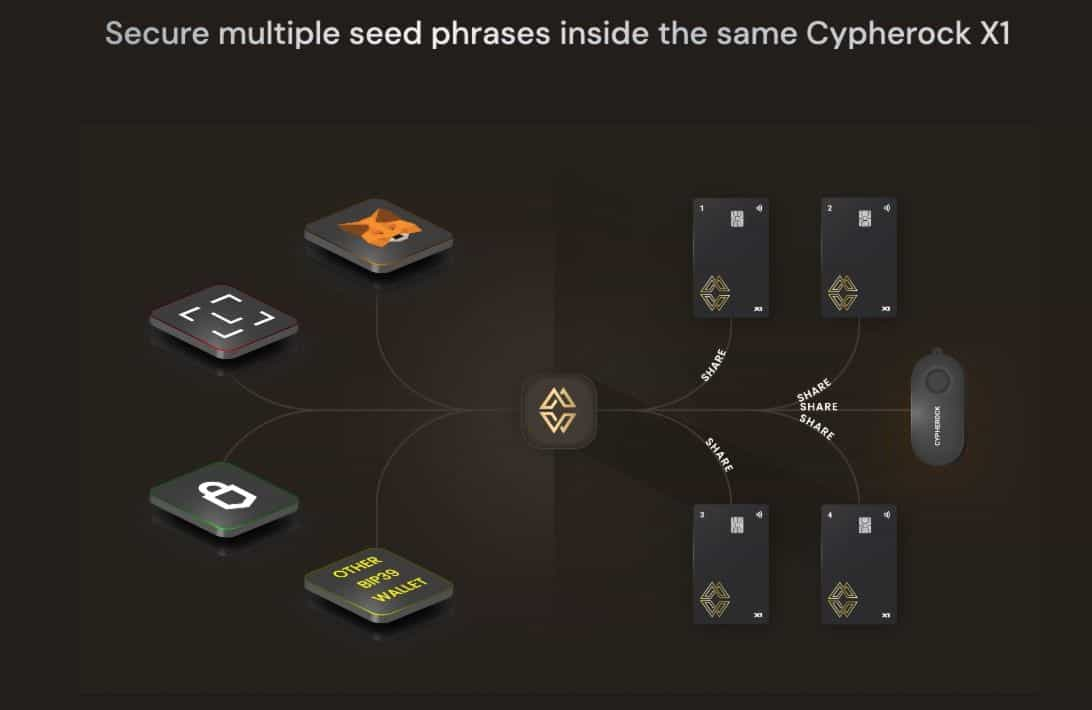
The Hardware
The X1 Vault boasts a sophisticated dual-chip design. The STM32L4, serving as the main microcontroller, works alongside the ATECC608A secure element for device authentication and key security. This setup, with ample memory for various cryptocurrencies, is fortified against side-channel attacks. The memory element is worth exploring as some hardware wallets such as the original Ledger Nano S could only store up to three different cryptocurrencies making it unsuitable for altcoin collectors. The Cypherock X1 Vault supports over 8,000 cryptocurrencies so you can hodl until your heart's content.
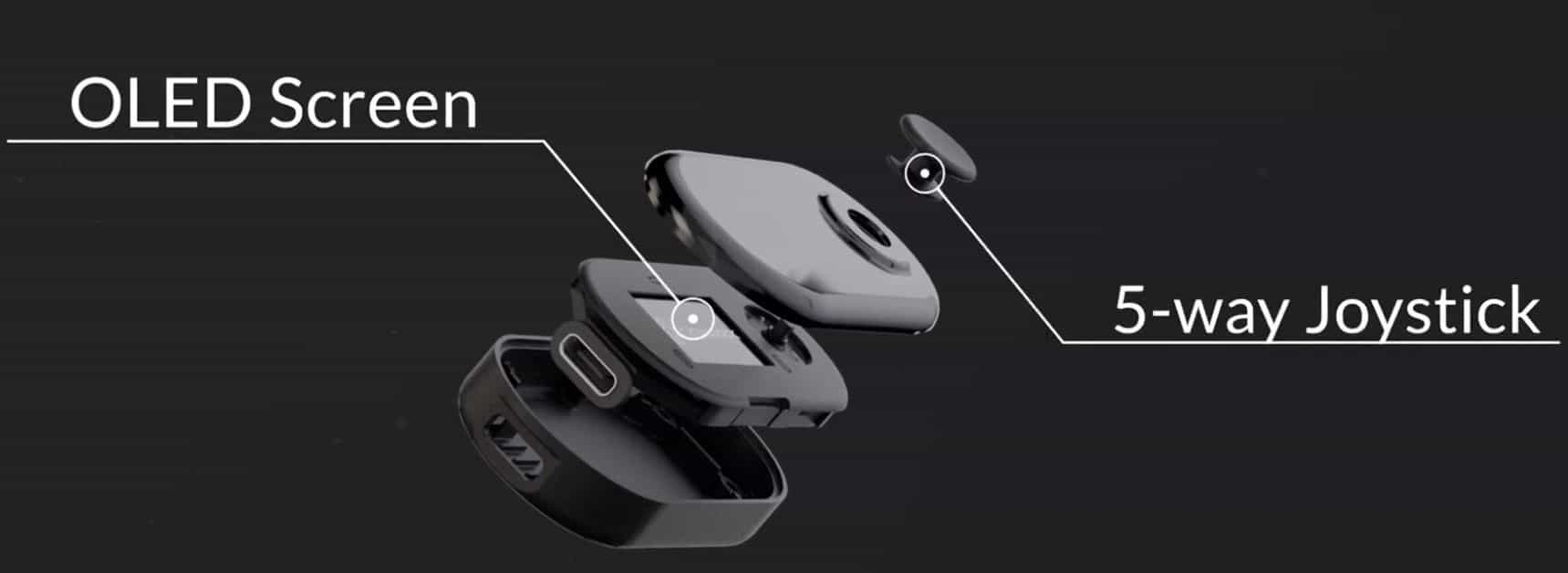
The X1 Vault features an OLED display and a 5-way joystick for user interaction. For those who are more technically inclined, the Cypherock docs give us this view of the device’s inner workings:
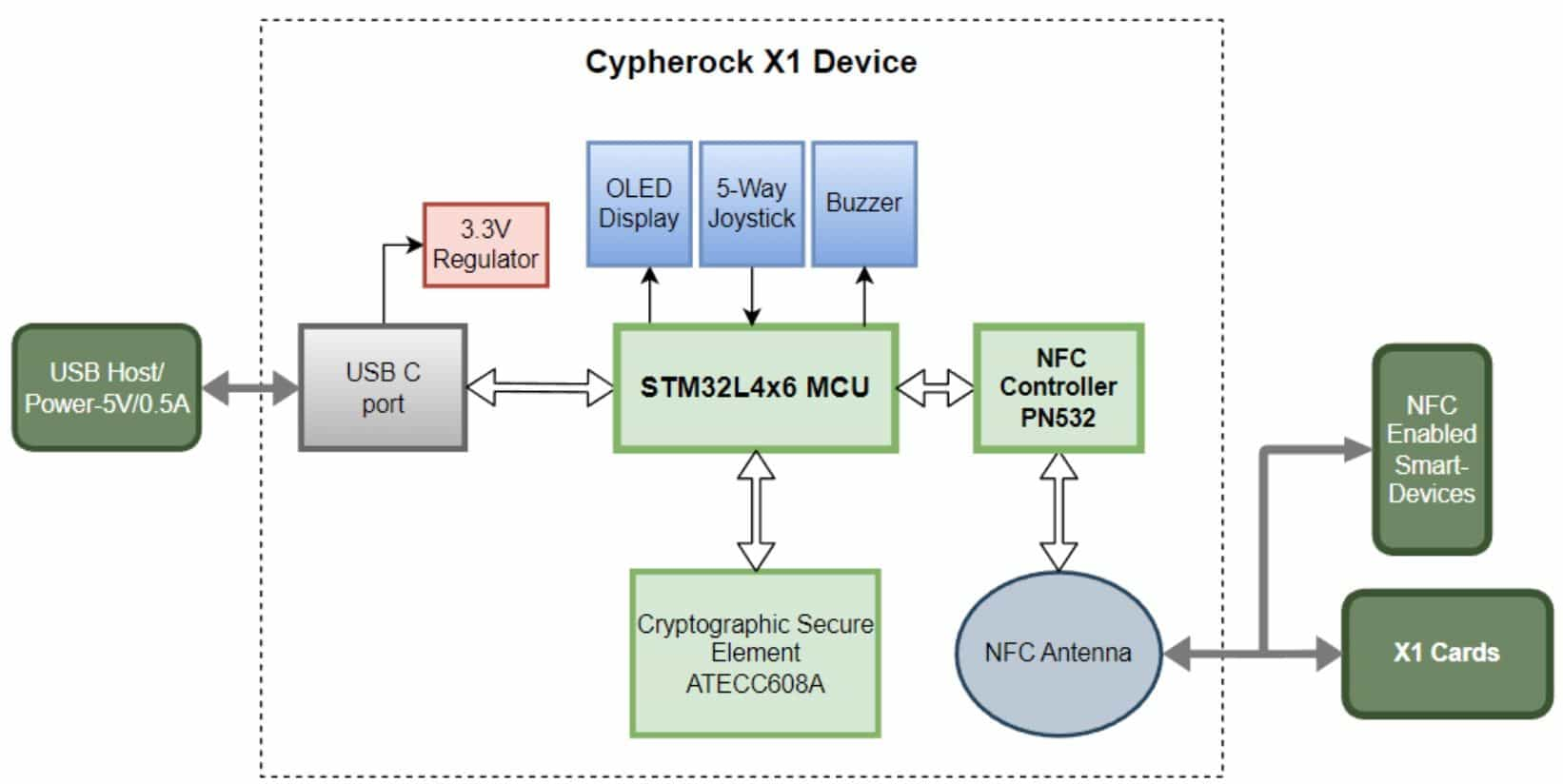
The X1 Cards are secure, durable and tamper-proof, running on Javacard OS with an EAL6+ security rating, the same security rating as credit and debit cards. Communication between the MCU and these cards is enabled by the PN532 over NFC, which also supports smartphone connectivity.
Here are the Cypherock specs:
- Size: 3x6.4x1.5 cm
- Weight: 200 gm
- USB Port: USB-C
- Screen: type: OLED Size: 0.96"
- Certifications: CC EAL6+
- Secure elements: ATECC608A (X1 Vault) , NXP JCOP3 (X1 Card)
- Compatibility: Windows, Mac, Linux (current) * and Android, IOS (Future)
Here are the contents of the box:
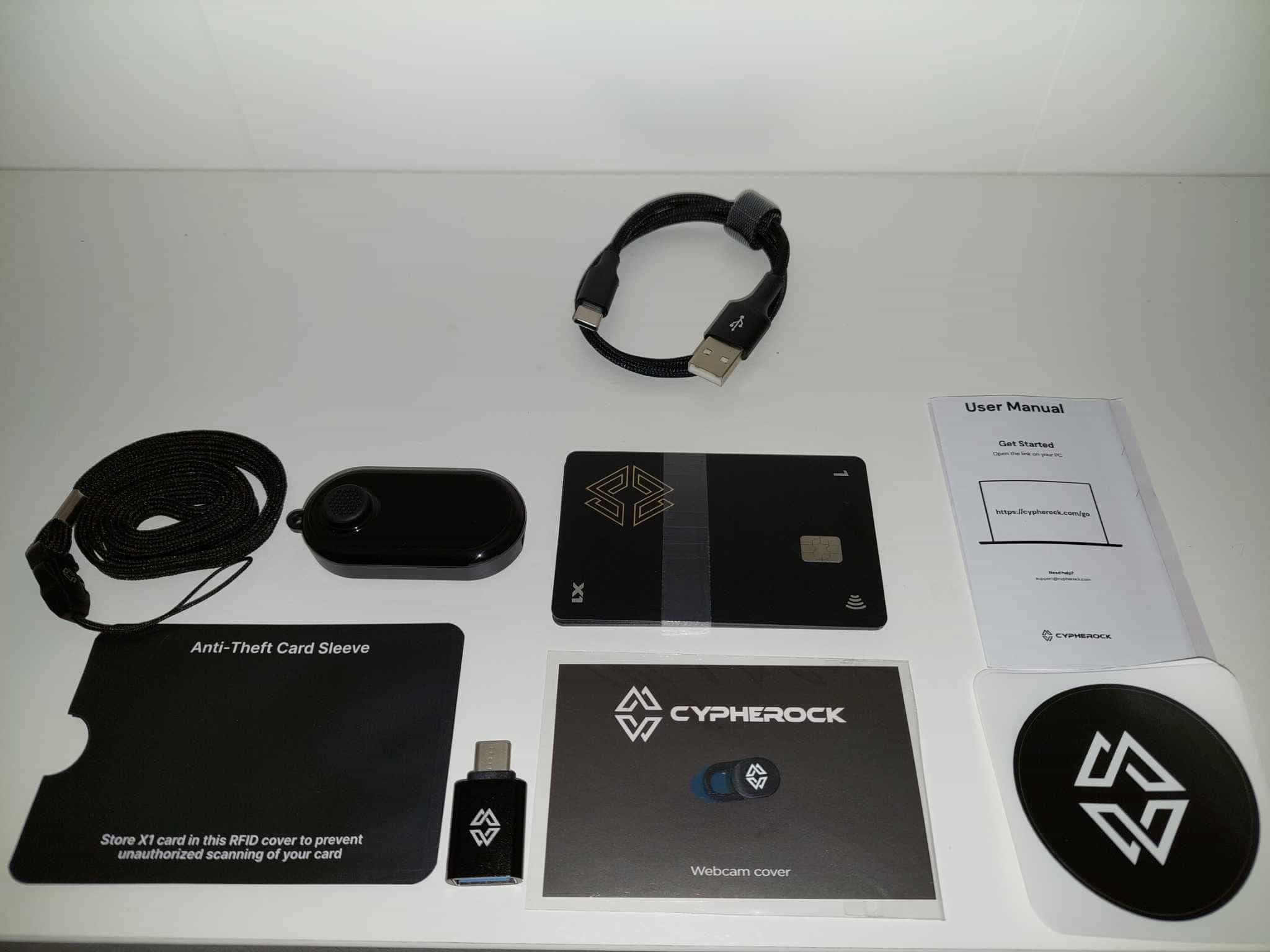
The product comes with:
- The X1 Vault
- 4 X1 Cards
- 4 Anti-Theft Card Sleeves
- 1 Lanyard
- 2 Stickers
- User Manual and Warranty Document
- USB-C with an OTG Adapter
- Webcam Cover
Cypherock Wallet Backup
The Cypherock wallet uses the ingenious Shamir's Secret Sharing for private key recovery. Say adios to the panic attacks about losing your recovery phrase or mismanaging it.
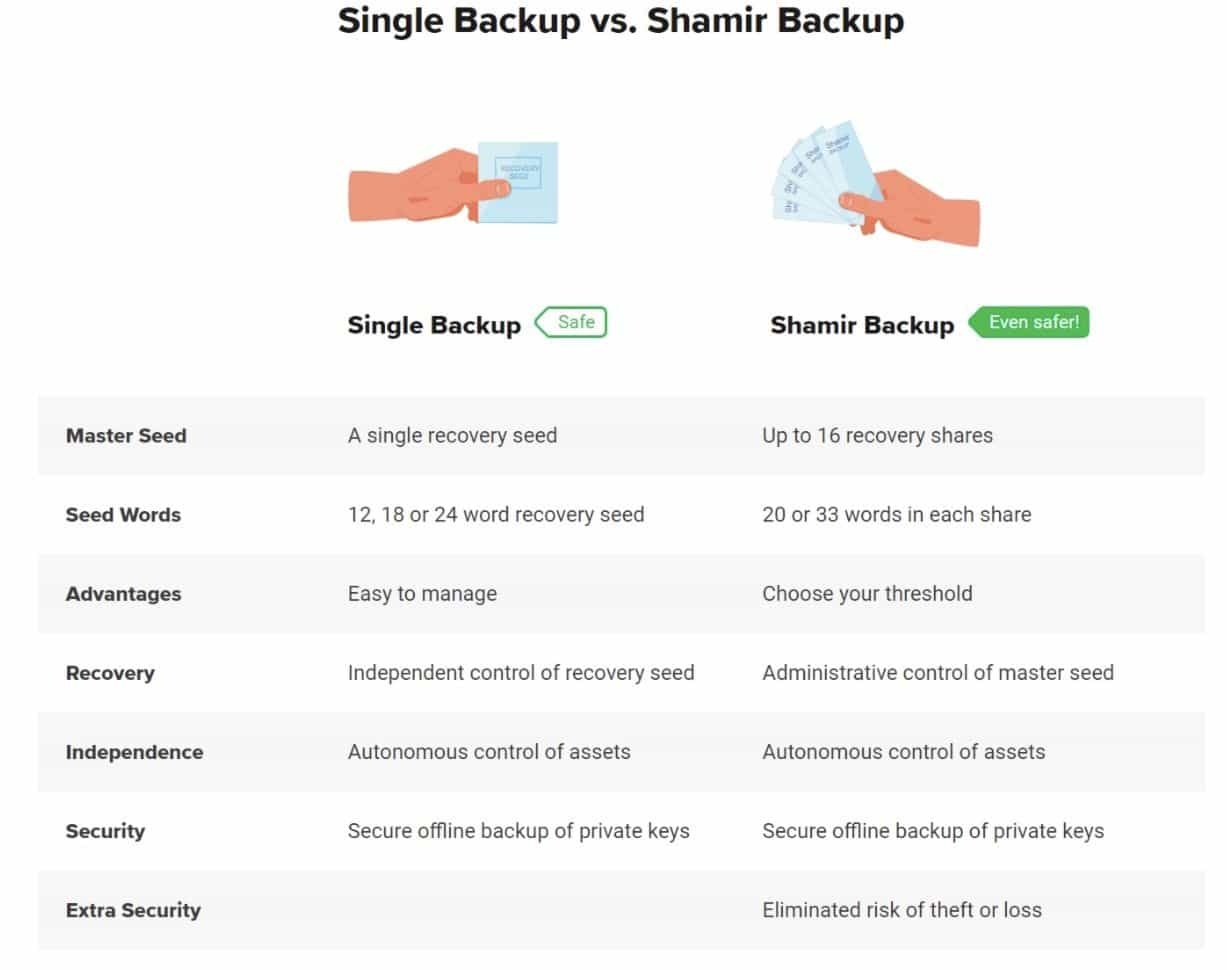
No More Hacks: In a world where everything seems hackable, from cloud storage to hardware wallets to password managers, Cypherock plays it smart. No online storage of your seed phrase means no remote attacks lurking in the shadows.
Physical Loss, Who Cares?: Forget the woes of physical loss or theft that haunt paper and metal backups. Cypherock safeguards against these all-too-common nightmares. As long as you have any two of the five parts that make up the Cypherock system, you will be able to restore your wallets. Extra cards and devices can also be ordered for additional backups.
Decentralized, As It Should Be: By not centralizing your seed phrases, Cypherock ensures you're not putting all your digital eggs in one basket. Eliminating the single point of failure is one of the best gifts you can give your future self.
Divide and Thrive: Your crypto seed phrase is cryptographically split into five parts. Store them in different corners of the world.
The Shamir Secret
In the X1 Vault's application of Shamir Secret Sharing, the Cypherock system functions as a secret sharing algorithm that processes every byte of the initial data (deemed as the secret in the algorithm) and divides it into N parts, each consisting of one byte.
The sharing strategy employed in the X1 Vault is the (2, 5)-threshold scheme, alternatively known as the 2-of-5 sharing scheme. In this scheme, any two out of the five cryptographic components generated can be employed to recover the original data or secret.
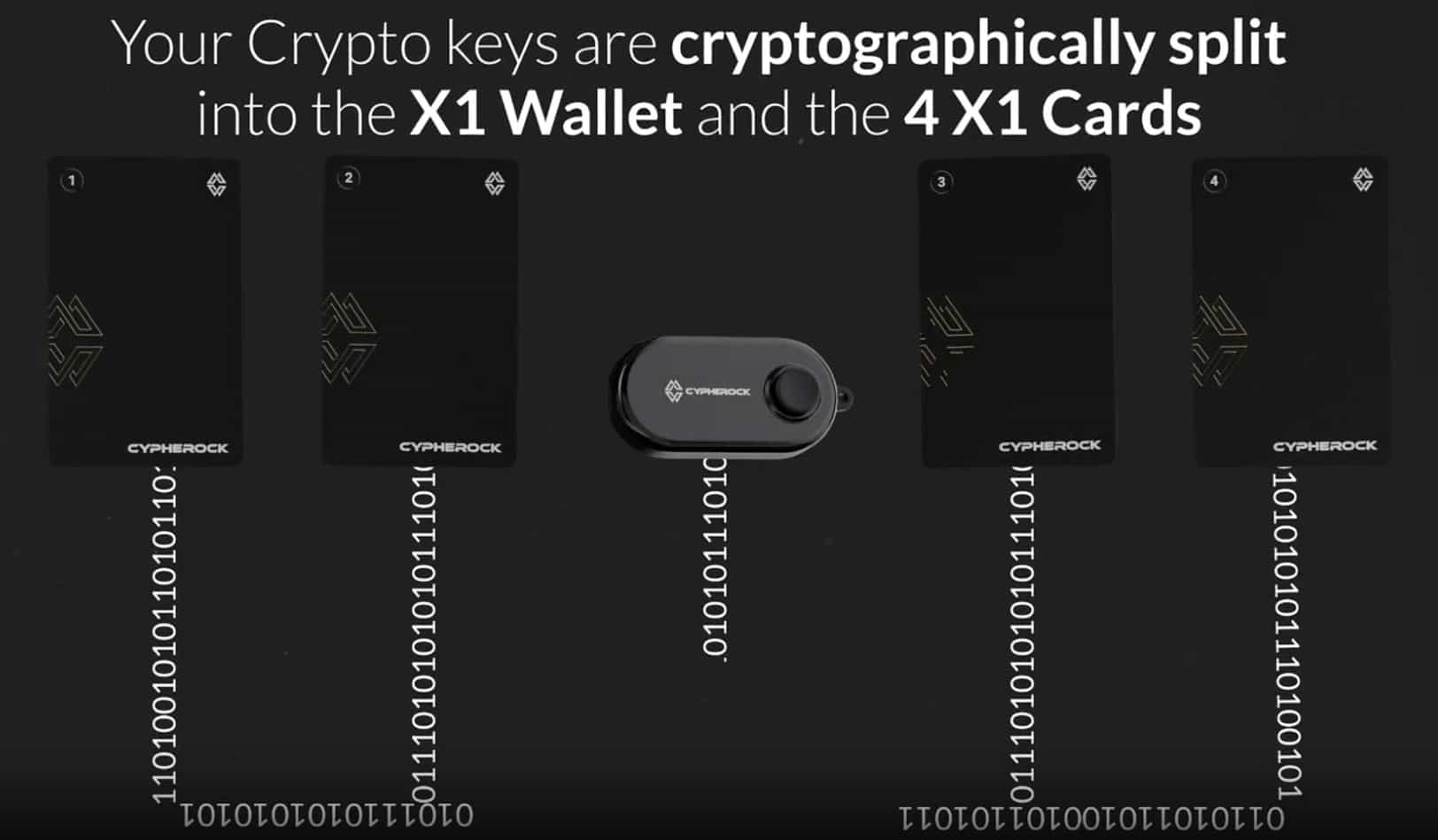
Shamir Secret Sharing empowers users to divide a secret into separate parts, wherein the original secret can be reconstructed with any 2 out of 5 pieces.
The owners decode the original secret using Lagrange polynomial after reaching the threshold parts. While SSS shares similarities with Multi-sig in methodology, it operates off-chain, whereas Multi-sig is entirely on-chain. In Multi-sig, distinct private keys contribute to generating a multi-sig address, while in SSS, a single private key is sharded into multiple parts. For a balance between accessibility and security, SSS is generally considered to be preferable for individuals, while Multi-sig is favored for enterprises. Here is a great document comparing and contrasting Shamir Secret Sharing vs Multi-Sig if you want to explore further.
Cypherock Wallet Recovery
Need to recover your seed phrase? Just a tap of one of the four cards on the X1 Vault and you're golden. No exposed seed phrases, no single point of failure – just pure, unadulterated peace of mind. After years of laminating and cleverly hiding paper recovery phrases around the house, hoping beyond hope that future me will be able to find them and read my chicken scratch writing, the Cypherock system relieves quite a bit of anxiety.
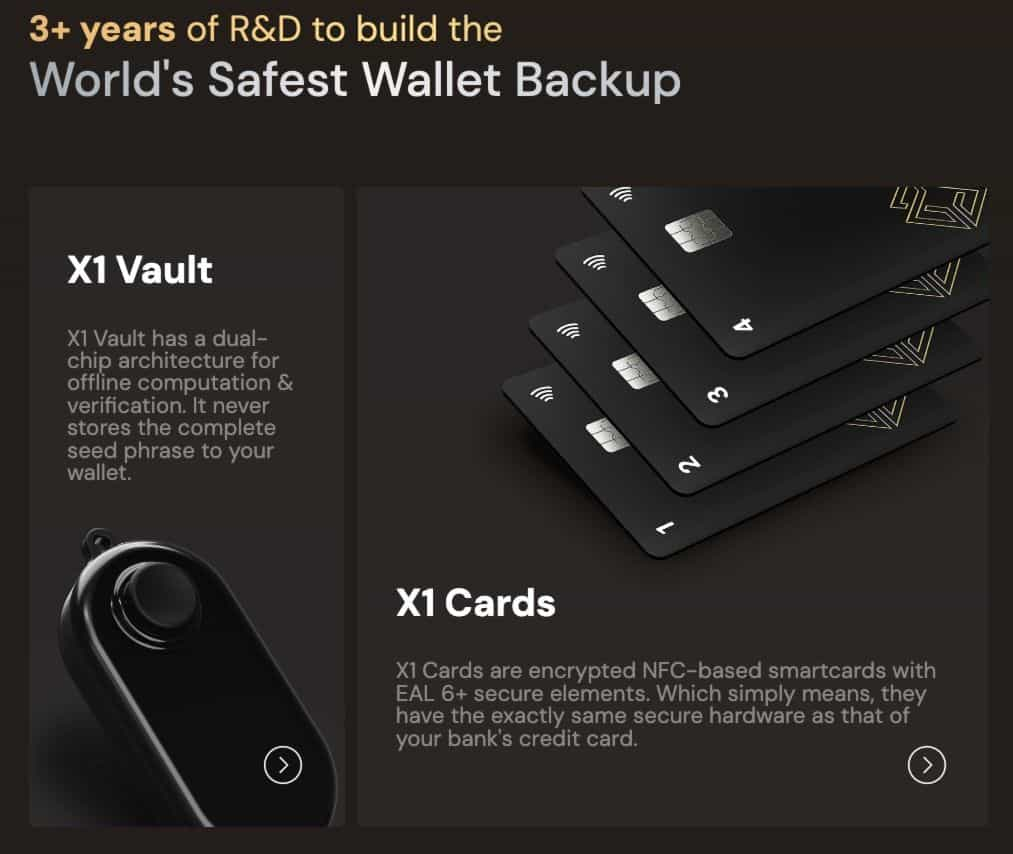
And I know the warning flags that go up when you hear about a wallet that doesn’t use the typical mnemonic phrase backup system, I wouldn’t want to trust one of those either, which is why I love that Cypherock users can still access their recovery phrase if they need be to import into any other wallet.
I am also hesitant about using any wallet that requires future reliance on the same wallet. If my wallet breaks or I lose it, I don’t want to be stuck up the river without a paddle. That is why I also appreciate that Cypherock will be releasing an open-source mobile app that can be used for recovery. As long as you have two cards, the mobile app will allow you to conveniently and securely recover your assets.
A Legacy Inheritance System
Let’s quickly touch on a not-so-fun topic… Death.
Well, that got dark quickly. Crypto investing and the concept of trustless self-custody have one major flaw: What happens to our assets when we die?

Inheritance is a tricky puzzle to solve for those of us in the crypto space. Crypto investors simultaneously want a financial system where there is no need to trust a third party, yet we also don’t want our assets to be unrecoverable in the event of an accident. There are countless stories of crypto investors passing on and their Bitcoin being lost forever.
There are a couple of wallet companies working to crack this conundrum and Cypherock is working on a very clever, yet simple solution that will be available soon. The team has asked me not to disclose the details, but it will certainly be a much-needed use case in the crypto space and I am excited about its rollout.
Portfolio Management
This is a feature that is unique to Cypherock and is quite useful. Portfolio management across multiple wallets can be a royal pain. The complexity deepens when managing portfolios across various blockchains, each with its own set of wallets and tools. Existing solutions fall short of providing a centralized way to oversee and manage these diverse portfolios.
Some wallets have attempted to address this poor user experience by creating multiple accounts within wallets like MetaMask, Ledger, or Trezor, treating each as a separate portfolio. However, complications arise as these wallets store only one master seedphrase, making individual backups cumbersome and risking the entire fund if one seedphrase is lost.
Here is how the traditional approach looks:

Cypherock enables users to create up to four distinct wallets, each with its own seedphrase, offering a level of segregation that turns each unique wallet into an independent hardware wallet. This innovation allows users to efficiently manage multiple portfolios, spanning various blockchains and asset types, all within the unified interface of the cySync App.
Here is how the above scenario would play out with Cypherock:

MetaMask and Phantom Wallet, Bitcoin, Ethereum and Solana all manageable from the same software interface? Nice..😎
Their platform allows you to manage private keys and sign transactions securely in one place. You're not just managing assets; you're fortifying them.
For Web3 Businesses- This is especially useful for users who need to track company and personal funds separately but don’t want the headache of multiple recovery phrases and wallets. Historically, there has been some confusion with funds being mixed between personal and business use, which is not only a big no-no but also illegal. Cypherock makes it easy to avoid the accidental co-mingling of funds.
Personal Users- Using private wallets for self-custody can mix up your portfolios and lead to fund mismanagement. Certain wallets also pose security risks during risky activities, potentially compromising all linked accounts. Cypherock X1 addresses this by enabling users to create four distinct and secure wallets with unique seed phrases, ensuring the safety of their funds. I would approach this by having one wallet for my long-term hodl stash and another wallet that I would use for DeFi exposure.
If you want to get into the step-by-step process of using the Cypherock Wallet, we also have a Cypherock Guide.
Cypherock Security
Now for the most important part. A wallet is only as good as its security, so let's see how the Cypherock X1 Vault stacks up.
Impervious to Remote Attacks
Remote attacks, those not reliant on physical possession of a wallet, encompass manipulations of data sent to the hardware wallet or control of devices communicating with it. For instance, if the wallet connects via USB to a computer, an attacker might exploit a USB software stack or application layer vulnerability.

Concerns about downloading malicious software leading to fund loss or potential malicious firmware updates have grown. Cypherock X1 addresses these with several protective measures:
Authenticity Check: Secure provisioning during initialization ensures the X1 Vault and X1 Cards remain untampered. An email authentication system validates the authenticity of the cySync app, safeguarding against supply chain attacks.
Seedless by Design: Cypherock X1 avoids exposing the seed phrase during wallet initialization, rendering phishing attacks redundant. Users are warned about the risks of revealing the seed phrase, guarding against social engineering attacks.
Non-Upgradable Hardware: To thwart internal rogue actors pushing malicious firmware or companies launching unwanted updates (looking at you, Ledger), private keys are never permanently stored on upgradable hardware. The upgradable X1 Vault stores 1 key shard, while the non-upgradable X1 Cards each store 4 key shards. Cypherock's open-source nature and validation by Wallet Scrutiny ensure firmware integrity.
Protector Sleeve: One thing I really appreciated was that the Cypherock came with 4 protector sleeves to slide the cards into. Each X1 card is encrypted NFC-enabled. As with bank cards, attackers may try and get close to the card to steal information. To prevent any unauthorized access, the X1 cards should be stored in the protector sleeves, which act as a Faraday cage, blocking electromagnetic fields.
Defence Against Physical Attacks
Robbery, AKA The $5 Wrench Attack
A $5 wrench attack involves a physical threat to obtain private keys or transfer funds. Cypherock takes specific measures to safeguard against this
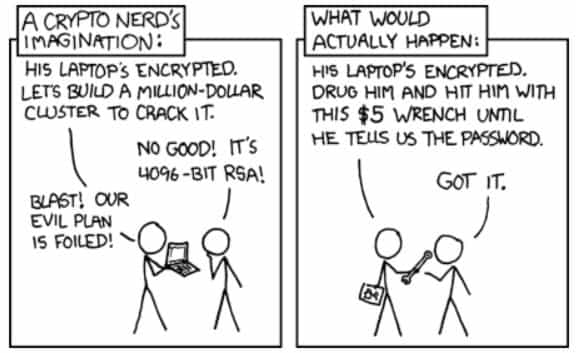
Geographical Separation of X1 Cards: Storing X1 cards in different locations enhances security, increasing the time and risk for attackers.
Multiple Wallets within Cypherock X1: The ability to create and manage four independent wallets adds flexibility. While a wallet without pin protection could be compromised, others with pin protection remain secure due to the complexity of guessing an alphanumeric pin and the implementation of an exponential time function.
Passphrase Protection: Adding an extra layer, passphrases enhance security by requiring an additional phrase beyond the PIN on your Cypherock X1. This passphrase combines with the existing seed phrase to generate a new wallet, strengthening protection.
Brute Force Pin Attempts
A PIN brute force attack is an attempt by hackers to gain unauthorized access to a crypto wallet by systematically guessing the correct PIN. Cypherock enhances user protection against this:
Alphanumeric PIN: Cypherock allows users to create an eight-digit alphanumeric PIN, significantly expanding the possible combinations compared to a numeric PIN.
CyLock Proof-of-Work System: To counter brute force attacks, Cypherock employs CyLock, a proof-of-work lock system that progressively extends the wallet lock duration with each incorrect attempt. Careful though, too many incorrect guesses could extend the time lock to days, weeks, months, or even years!
Secure PIN Storage: The PIN is never stored on the X1 Vault directly. If a user sets a PIN, the Cryptographic part undergoes encryption and is then stored in the NVM of the STM32. Decryption utilizes the first PIN hash, with the nonce for encryption stored on the X1 cards, enhancing security by acting as a salt in conjunction with the PIN hash.
Evil Maid Attack
Involves gaining unauthorized access to sensitive information by physically accessing a device or system. This term suggests a scenario where a hotel maid, for instance, could discreetly access a user's device in their absence, putting the user's data at risk.
In the realm of cryptography, this attack typically occurs when a hacker physically accesses an unattended computer or device to install malicious software, replace hardware components, or extract cryptographic keys. The aim is often to access encrypted data or passwords, potentially leading to unauthorized access to wallet private keys and fund drainage.
Cypherock addresses the risks of evil maid attacks through the following measures:
Ultrasonic Welding on the X1 Vault: Utilizing ultrasonic welding makes it challenging for attackers to compromise the wallet without leaving detectable damage, alerting the owner to any tampering.
Signed Official Firmware: Cypherock ensures firmware integrity by signing it with proprietary keys during the provisioning process, allowing users to verify the authenticity of their X1 Vault.
Elimination of Single Point of Failure: Cypherock's architecture eliminates the single point of failure with private keys by employing Shamir Secret Sharing. As the private key is cryptographically split into 5 parts stored individually, any 1 X1 Card and the X1 Vault for a transaction, each cryptographic part's independent security significantly raises the difficulty of evil maid attacks.
Flash Attacks
A flash attack targets the firmware of a crypto hardware wallet, replacing the legitimate firmware with a malicious version to gain access to private keys and sensitive information. Cypherock employs various safeguards against such attacks:
Immutable Bootloader Code: The X1 Vault features an immutable bootloader code that tracks firmware version history. This information is safeguarded against factory resets. During upgrades, the bootloader checks the new firmware version against the last installed version, aborting if the new version is lower.
No Unsigned Firmware: The X1 Vault's bootloader prohibits flashing unsigned firmware. The upgrade package includes a signed header, two signatures of the firmware binary, and the firmware binary. Incomplete upgrades occur if signatures are unverified.
Provisioning Mechanism: Cypherock ensures wallet integrity through a provisioning process, confirming the authenticity and untampered nature of the X1 Vault and X1 Cards. Further details on the provisioning process can be explored to ensure the authenticity of Cypherock X1.
Side Channel Attack
A side-channel attack focuses on the physical implementation of a cryptographic system, like a hardware wallet, exploiting leaked information through side channels like power consumption or electromagnetic radiation. Cypherock employs robust protection against such attacks:
SCA-Protected PIN Verification: Wallet PIN verification occurs inside the EAL 6+ certified X1 card environment, securing it against side-channel attacks. No PIN verification takes place on the device.
Limited Storage of Shamir's Secret Share: X1 Vault stores only 1/5 of Shamir's secret share, optionally encrypted with the wallet PIN if set by the user. So even if a hacker physically hacks into the X1 Vault, they will not have a complete private key.
Secure X1 Card Data Transmission: X1 Card data, including the wallet's Shamir's secret share, is padded with a random IV generated on the card, encrypted by the pairing key. This prevents adversaries from reverse engineering communications between the X1 Vault and X1 Card.
Temporary Private Key Storage: The private key is regenerated on the device during transactions and promptly wiped from local buffers once no longer needed, ensuring brief exposure in temporary memory.
Time-Invariant Memory Comparison in X1 Vault: The X1 Vault bootloader's time-invariant implementation of memory comparison software logic guards against side-channel vulnerabilities during firmware boot.
Supply Chain Attack
A supply chain attack in crypto hardware involves compromising a cryptocurrency hardware wallet by tampering with its supply chain. For hardware wallets, ensuring a secure supply chain extends to both software and hardware. Cypherock addresses these concerns:
Software Security: Cypherock wallet emphasizes user verification of software authenticity, minimizing risks associated with malware from unofficial sources. The cySync app is downloadable from Cypherock's official website and GitHub.
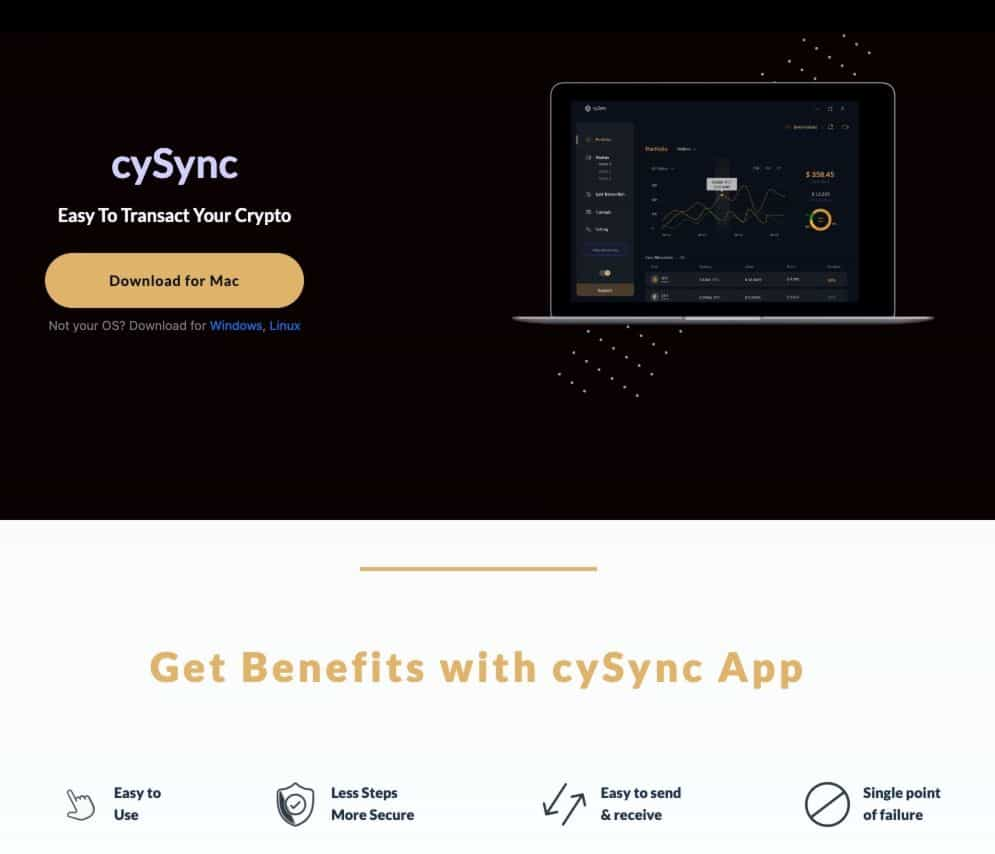
Hardware Integrity: Measures are in place to ensure the integrity of chips and firmware. Cypherock utilizes a secure provisioning method to detect any malicious changes in the X1 Vault's hardware or firmware.
Authentication Protocols: Before use, the X1 Vault and X1 Card authenticate each other, establishing an end-to-end encrypted session. This authentication fails if any device or card lacks verification as an authentic Cypherock product.
Provisioning with Unique Keys: Each device is provisioned with a unique set of private-public keys for device authentication and NFC card pairing before shipment. Authentication involves signature verification by the server using the corresponding public key.
How The 24-Word Secret Phrase is Generated
Generating 256-bit entropy is achieved through FIPS-compliant True Random Number Generators (TRNG) in the ATECC608 secure element and STM32L4 MCU. Both components independently produce 32 bytes (256 bits) of entropy, which are combined using XOR, a fail-safe against potential backdoors.
Unlike other wallets, Cypherock disperses the output using Shamir Secret Sharing at the entropy level, splitting the 256 bits into 5 parts stored across the X1 Vault and 4 X1 cards. A 2/5 threshold ensures that any two components can reconstruct the seed phrase, enhancing security against single points of failure.
What Happens if Cypherock Goes Out Of Business?
It is important for crypto users to always have trustless self-custodial access to their crypto and being reliant on one wallet manufacturer is never a good idea, which is why most wallet providers have adopted the same standard for recovery phrase generation.
Cypherock does not use recovery phrases in the traditional sense, which is one of the key selling features for enhanced security, but fear not as this does not mean once you choose a Cypherock that you are locked in with that wallet for life.
The Cypherock is still BIP39 compatible, which is the standard used by the vast majority of wallet manufacturers, both hardware and software. Cypherock users can import and manage existing seed phrases, and also view and export seed phrases if they wish. However, this should only be done if you are planning on importing to a new wallet as the action of exporting your seed phrase negates the extra robust security measures of the Cypherock and the Shamir backup method.
To view the seed phrase, you will need your device alongside one of the Cypherock cards. Then simply follow these steps:
- Select the wallet from the main menu
- Click on the wallet and navigate to 'View Seed' in the menu
- Enter the PIN that you have set for the wallet (if you have set a PIN).
- Tap any one of your Cypherock cards on the device to view your seed phrase
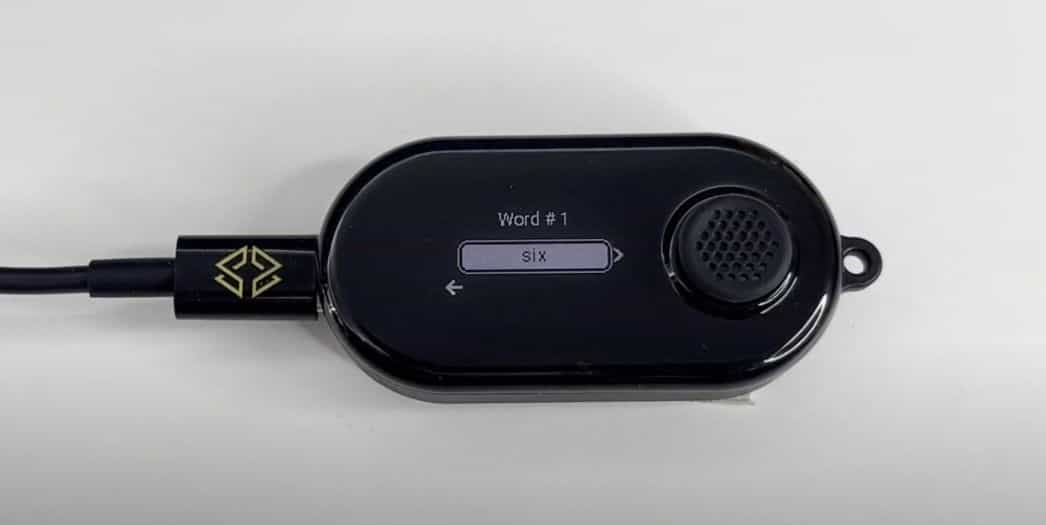
Now, if Cypherock goes out of business AND your device breaks, Cypherock has a redundancy for that too.
The company will be releasing an open-source Android and IOS app that will allow the users to tap their cards directly on the NFT-enabled smartphone to recover the seedphrase by entering the pin on the phone. Very nice touch to also have this as a backup for extra confidence that you won’t lose access to your funds with Cypherock.
Audited by Keylabs
What do leading hardware wallet manufacturers Trezor and Ledger have in common? They were both audited and found to have significant security vulnerabilities by Keylabs.
Keylabs is one of the most respected security auditing companies in the crypto industry, being behind some of the largest whitehat hacking discoveries behind many of the devices that are trusted by millions of crypto users.
Cypherock are so confident in the security of their hardware wallet that they invited Keylabs to take a crack at the Cypherock. We opened up this article with a quote from Keylabs, which sums the report up nicely.
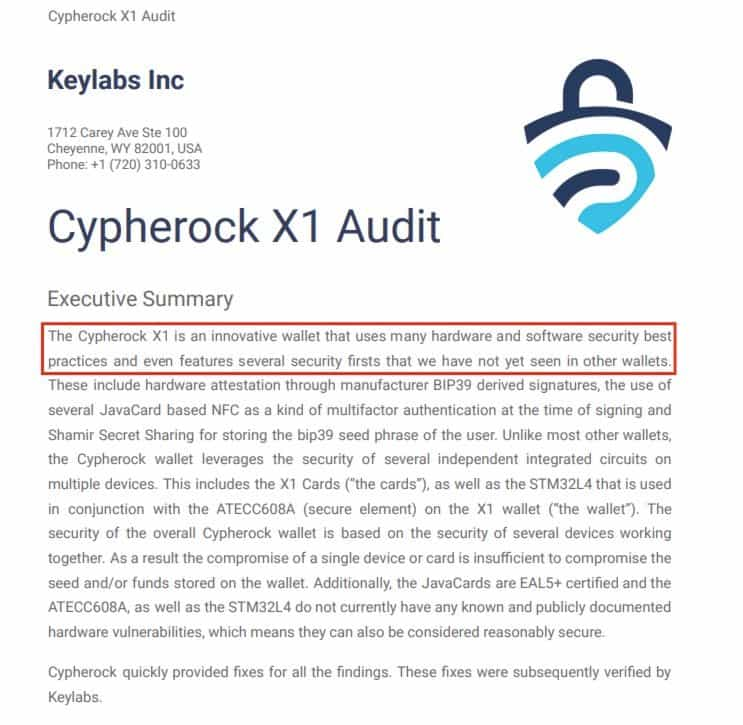
A thumbs-up from one of the most respected security firms in the industry is a good sign.
Here’s the summation and our interpretation of the report:
The Hardware:
The report highlights a common security vulnerability with the consumer-grade microcontroller, stating that it is reasonable to assume that the component will be the weakest link in Cypherock security. But the Cypherock team understood this during the design phase and Keylabs goes on to explain that because the microcontroller is secured by the ATECC608A microchip and provisioned at manufacturing time, this mitigates the attack surface.
This is a way of saying that the device is protected against attackers trying to replace the STM32L4 MCU with a malicious one would not be possible because of how the STM32 is paired with the ATECC608A microchip. As Cypherock programs both the STM32L4 and the ATEC608A during manufacturing, and each generates a pairing key for their communication, replacing either of these components, such as substituting the STM32L4 with malicious firmware, is rendered impossible. There are also no known publicly documented attacks against either the STM32L4 or the ATECC608A.
Keylabs touches on how firmware vulnerabilities impact the software of hardware wallets, potentially compromising overall security, especially vulnerabilities in the bootloader. As Cypherock uses a Shamir Secret Sharing protocol for cryptographic seed splitting, compromising the physical wallet necessitates exploiting at least one X1 Card. Given the EAL5+ certification and vendor-certified OS of X1 Cards, coupled with Cypherock's JavaCard applet, it's reasonable to assume an attacker will unlikely be able to exploit the device with any known methods.
The STM32 family commonly found in wallets is recognized for its susceptibility to exploitation. In such an attack, an assailant could potentially downgrade the X1 Vault to RDP1 and access RAM, for instance. Nevertheless, these attack scenarios are not practically applicable to the STM32L4 due to its absence of an exploitable external Vcore voltage. Additionally, there's a rationale suggesting that PCROP-capable STM32 microcontrollers, including the STM32L4, are less vulnerable in practical terms, adding another feather in the cap of Cypherock over many other wallets.
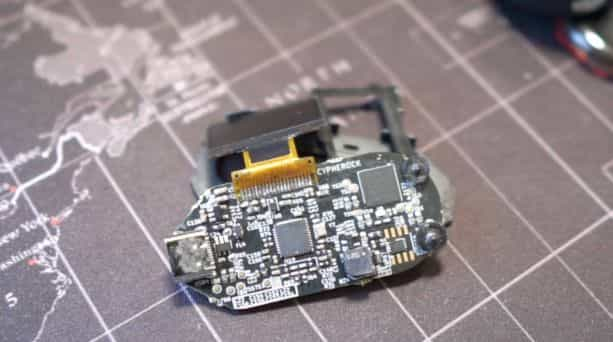
Encrypted NFC Communication:
The X1 Cards communicate with the X1 Vault via NFC, enhancing user experience and paving the way for compatibility with mobile phones and POS systems. Addressing the security concerns associated with NFC, Cypherock has fortified the communication with end-to-end encryption. This layer of protection ensures that extracting valuable information from the Cypherock X1 becomes an infeasible task for potential attackers.
Javacards over MicroSD:
Cypherock chose Javacards over SD Cards as it is nearly impossible to identify if an SD card is authentic as it doesn't support custom logic. Also, SD card communication with smartphones isn’t exactly intuitive as extra hardware is needed if users want to interact with an SD card on a smartphone.
Javacards, with their NFC capabilities, can easily and securely transmit data. And let's not forget, Javacards have been in the banking big leagues for ages, securing our bank-held funds, while SD cards are more the 'store your holiday photos' type.
USB Over QR Code:
Many users have come to appreciate QR code functionality when it comes to crypto wallets, but Cypherock chose a different approach as they felt QR codes are more hype than help. They don't really boost security and they sure can make the user experience clunky.
- QR codes and data-heavy transactions don't mix. Transferring heaps of transaction data via QR can be quite slow, whereas USB does it in a flash.
- QR codes can be a playground for phishing fiends, tricking users into scanning dodgy addresses. Plus, let's face it, most folks don't double-check addresses when using QR.
- And firmware updates with QR codes? Forget about it. You'd likely have to resort to USB or SD cards anyway.
Non-Upgradeable Cards:
In the evolving web3 realm, trust in wallet providers is crucial. Yet, there's always that slim chance of a rogue engineer in the mix, potentially pushing harmful updates that could swipe your keys. Cypherock counters this with unupgradable X1 Cards, while still ensuring the wallet stays up-to-date with new coins and features.
As private keys are split into five parts, scattered across the X1 Vault and Cards, this design is a masterstroke against insider threats, making it virtually impossible for even a Cypherock insider with ill intentions to remotely mess with your crypto stash.
Unauthorized Private Key Extraction? Good Luck!
Many crypto holders were shocked to find out how easy it was to extract information from physical Ledger and Trezor devices.
The Cypherock X1 adopts a decoupled architecture, distinguishing itself from other wallets. Computation takes place within the X1 Vault, while storage is distributed as five cryptographic parts among the X1 Vault and four X1 Cards. Notably, the X1 Vault refrains from permanently storing entire private keys or seed phrases. Instead, it retains user-created wallet names and an encrypted cryptographic part (excluding MAC and nonce) for each wallet in its flash memory.
Upon wallet creation or restoration on the X1 Vault, the ENT, as detailed earlier, undergoes sharding, and the resulting shards are transmitted to the X1 Cards. During the reconstruction phase from the X1 Cards, the privately generated key from the threshold shards is temporarily stored in the X1 Vault's RAM. This storage is transient, as the private keys persist only until the transaction is signed or the user records the seed phrase.
Shutting down the X1 Vault at this juncture erases private key persistence. In a static state, the X1 Vault never retains complete private key information, rendering the information inconsequential even in the unlikely event of a successful attack. Throughout the product lifecycle, the entire private key is never stored in the flash memory of the generic microcontroller, making the extraction of private keys nearly impossible.
Consequently, Cypherock X1 exhibits resistance to physical attacks, a notable advantage over other hardware and software wallets.
Scrutinized By WalletScrutiny
Another notable team took a crack at finding faults with the Cypherock and there are some impressive findings here worth covering as well.
WalletScrutiny is a company that goes through popular wallets with a fine-toothed comb, helping crypto users understand what to look for when considering crypto wallets.
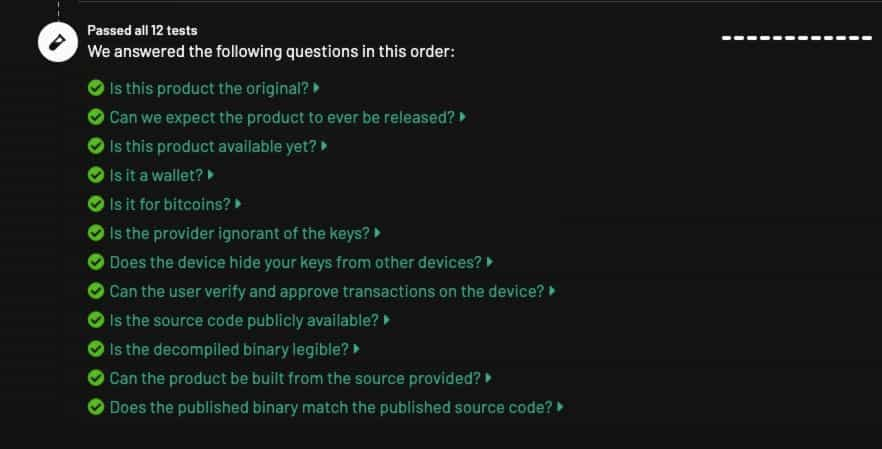
The WalletScrutiny team measures wallets on 12 key criteria as shown above. We found this quite impressive as not many wallets we’ve reviewed pass all 12 tests. Here are Ledger’s Nano S results for comparison
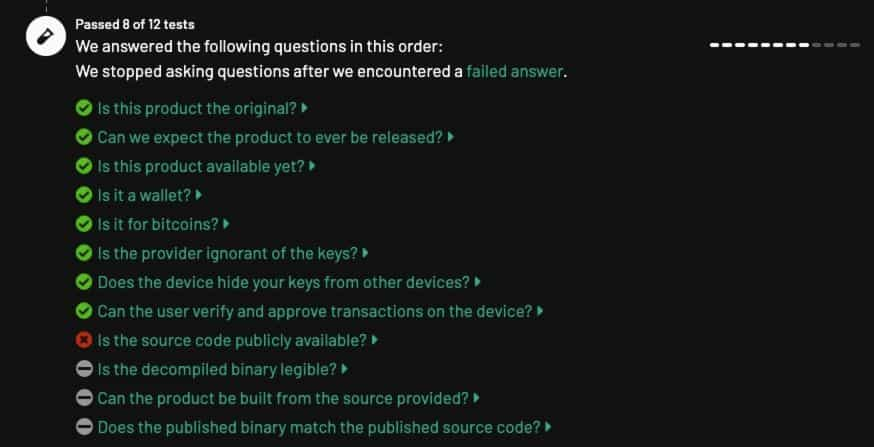
This is not to say that other wallets are not safe if they don’t pass all 12 tests and the importance of some of the testing criteria is debatable among crypto users.
I like to think of this testing outcome as a simple matter of the hardware wallet industry maturing and evolving. Industry pioneers like Trezor and Ledger built a foundation and the torch is simply being passed onto new innovators in the industry. New technology is always being developed and improving upon previous iterations, the hardware wallet industry is no different.
cySync Desktop App
Similar to Ledger with Ledger Live and Trezor with Trezor Suite, Cypherock interfaces with a desktop application called cySync.
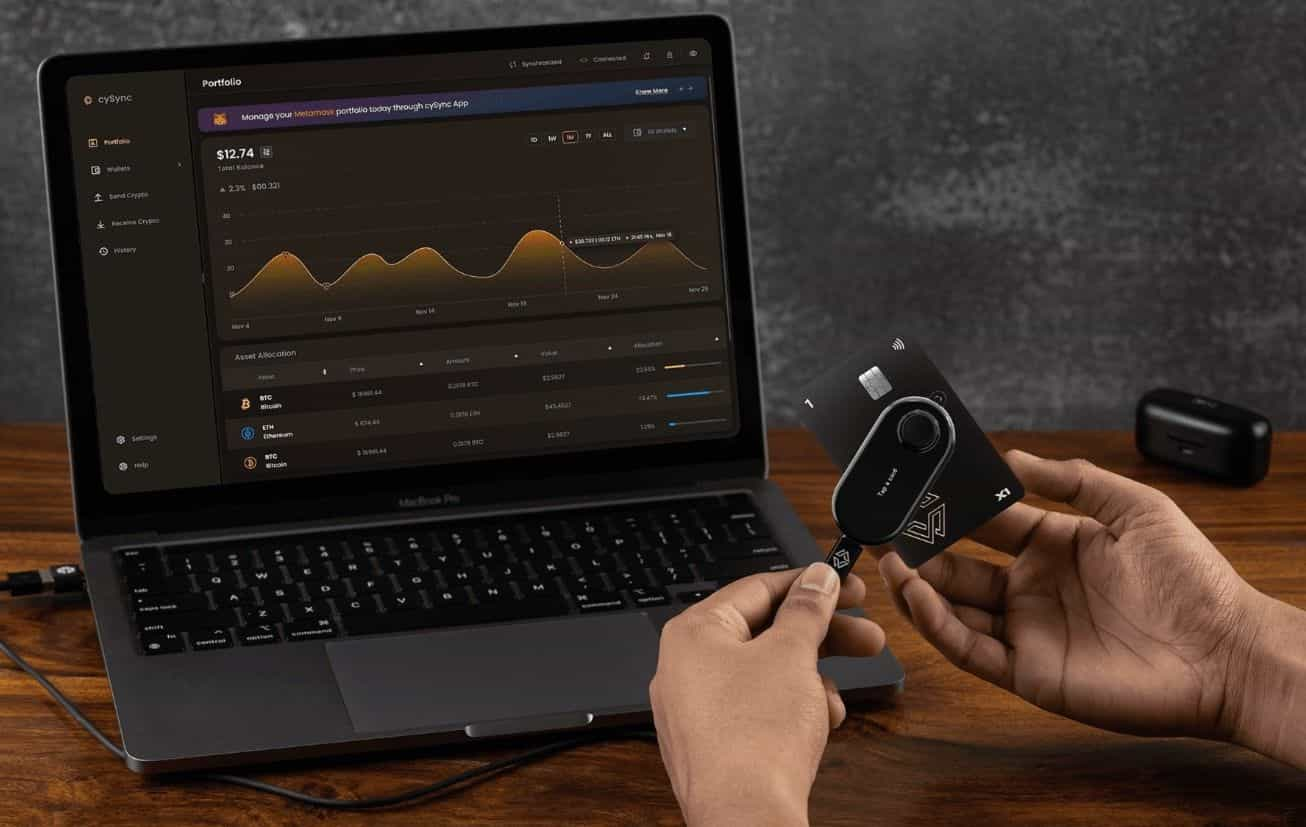
The program is well-designed and aesthetically pleasing, providing a great interface for not only interacting with your funds but functioning as a portfolio manager and seed phrase vault in a user-friendly manner.
Transacting with the system was also straightforward and intuitive, so sending and receiving assets was easy. While everything worked as expected, it would be nice to see more functionality added in the future such as the ability to buy and sell crypto or make swaps from within the cySync platform. This additional functionality can currently be completed using Wallet Connect and interfacing with DApps and DeFi, but being able to do everything within the app would be great.
Cypherock Asset Support
Cypherock supports an impressive 8,000+ assets with the majors like Bitcoin, Ethereum, Polygon, and Avalanche being covered, along with plenty of small-cap coins.
The ERC20 ecosystem is well covered and the Cypherock is capable of storing thousands of assets, so there are no low memory issues here. You can find a full list on the Cypherock Coin Support Page.
Cypherock Vs Other Card-Style Wallets
We’ve already touched on the ways in which Cypherock has multiple strengths over traditional wallets like Trezor, Ledger, and any that use the traditional recovery phrase, but there have been quite a few entrants into the self-custody space offering similar card-style functionality.
Wallets such as Tangem, Gridplus and CoolWallet are offering innovative approaches to crypto custody, providing users with a welcome alternative to the norm. However, it is worth exploring different concepts and understanding that not all card-style wallets are equal.
Though the Cypherock has a card system, it is not the same as the other popular purely card-style wallets. This is primarily due to the fact that Cypherock never stores the complete private key permanently in a single place. This is in stark contrast to other products in this niche.
Each X1 card only holds 1 of the 5 Shamir shares. Unlike other wallets that have cards as part of the setup or use the card as a transaction signing device itself, Cypherock is never subject to a single point of failure in private key storage.
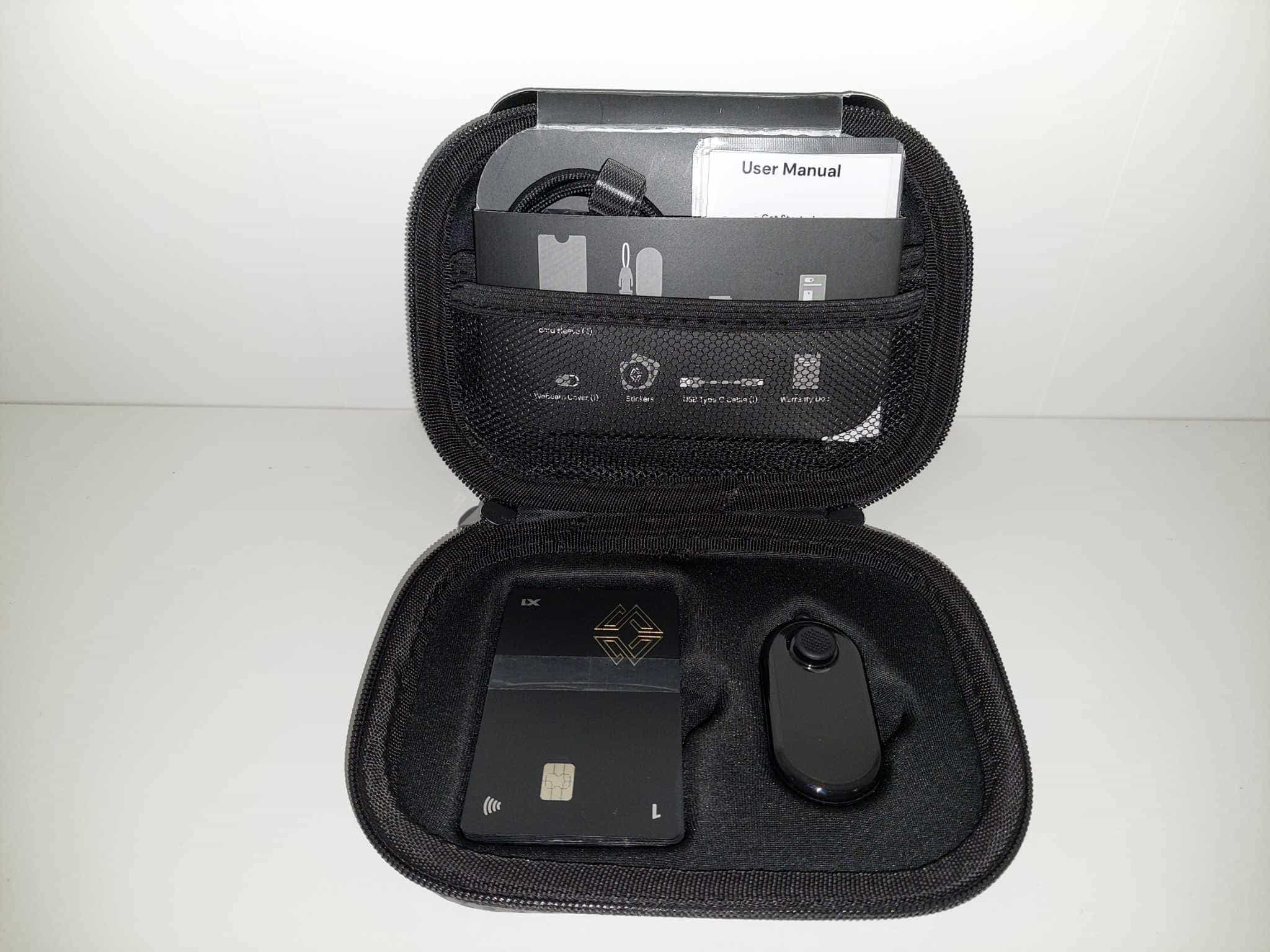
Also, Unlike other card-based wallets, the transaction signing does not happen on the cards, it happens on the X1 Vault. This is important since there is a display on the X1 Vault itself for the users to verify the transaction details in an offline way before authorizing the transaction.
Another possible attack vector could be that the compromised smartphone may initiate a malicious firmware update
Cypherock X1 mitigates this by never allowing firmware update on the card but only on the X1 Vault to support new features and coins.
Another potential vulnerability that could be exploited with other card-based wallets is the lack of on-device authorization since the PIN is entered on the smartphone. If the smartphone is hacked, the PIN can be recorded and be used to next time authorize a malicious operation by just tapping the card. Cypherock X1 solves this by having a manual confirmation on operations by the user on the device through the joystick and even the PIN is entered on the offline device (the X1 Vault) and not the PC/Smartphone.
To sum up, card-based wallets, while better than keeping funds on an exchange or solely relying on the use of a software wallet, have some flaws. Card-based wallets that interface with a smartphone can essentially become a single-factor authentication device should the smartphone become compromised. The Cypherock, on the other hand, can safely be used with a device that is riddled with malware or viruses as it acts as an effective 3-factor authentication thanks to the card, the device itself, and the pin.
What We Like About Cypherock
Well, if you’ve made it this far in the review, it is clear to see that there isn’t much NOT to like about Cypherock. It truly is an impressive piece of kit and a revolution in crypto security. For us, removing the single point of failure risk with recovery phrases is a huge game changer and the fact that the device can be used as both a portfolio manager and a vault to securely manage up to 4 wallets makes the life of a hodler that much easier.
I also like that with the pin protection, this device can be safely shared between users, no need for everyone to buy their own hardware wallets.
The final thing that we appreciated was the very nice and thoughtful addition of the hard case with each purchase.

This isn't just any hard case. It provides splash and dust resistance and significant protection against drops and bumps, but more importantly, protects against Electromagnetic waves, similar to a Faraday cage. Many security experts tout the importance of keeping hardware wallets and bank cards protected against EMPs and the like, so this is a great value-add as cases like this can go for an additional $50-$75.
What Could Be Improved
From a security perspective, I can’t think of much. From a convenience standpoint, it would be nice to see the cySync app offer a bit more functionality in the way of buying, selling and trading assets.
Also, the plastic design feels a bit fragile. Although the device has been drop-tested and uses ultrasonic welding, I found myself handling the device delicately, afraid of dropping it. I have made similar criticisms of other plastic Trezor devices as well, which is in contrast to metal-built wallets like the NGRAVE or BC Vault, which feel like they could endure a good toss out a window and still work fine. I guess it's a good thing that Cypherock provides the hard case, making the device essentially apocalypse-proof.
Cypherock Review: Conclusion
And that brings us to the close of our Cypherock review. We were quite surprised with everything we’ve uncovered during this review and are pleased to see how far the self-custody game has come. But that leaves us with an important question:
Am I Trusting the Cypherock With My Crypto?
Absolutely! Over the past four years, I have had the privilege of reviewing A LOT of wallets and using about a dozen of them myself. Also, before my time at the Coin Bureau, I worked for a crypto wallet company as a quality control analyst and support member where I learned and experienced a lot.
There has always been one common heartbreaking theme I have heard time and time again, and that is the sad story of crypto users losing all their funds due to mishandled recovery phrases. There are thousands of stories all over the internet of this happening and if you think it can't happen to you, I would think twice.
Even after all my years of experience and becoming an expert in the realm of crypto hardware wallets, I recently had a scare with a recovery phrase mishap that nearly resulted in significant losses. I was quite surprised as it was a routine action I had done hundreds of times before and knowing that I had made such a small, yet impactful mistake was humbling. After diving deep into wallets that have no recovery phrase vulnerability and can be backed up and recovered safely and securely, I have made the decision to move away from wallets that rely on a recovery phrase.
However, it is also important to never keep all your funds in one wallet. While I have always been a fan of Trezor, I will be using wallets like Cypherock, BC Vault and Zengo to keep my crypto AND backups secure and never be kept awake at night again worrying about the fact there is a piece of paper or metal out there that anything can happen to or anyone could find that would result in complete loss of funds. Who needs that stress in their life?
Frequently Asked Questions
Yes, we believe so. The wallet is open source and has passed security audits by both Key Labs and WalletScrutiny. Cypherock is believed to be a secure option as there is no single point of failure risk and the wallet design encompasses both software and hardware security best practices.
Yes, the Cypherock provides a secure and convenient method for travelling while storing crypto. The device can go through an X-ray machine without being damaged and the 3-factor authentication of the device ensures a high-level of security. Users can consider travelling with the X1 device and mailing one of the cards to their destination to reduce risk adequately.
Cypherock supports over 8,000 assets and can store thousands at any point in time.
Disclaimer: These are the writer’s opinions and should not be considered investment advice. Readers should do their own research.


